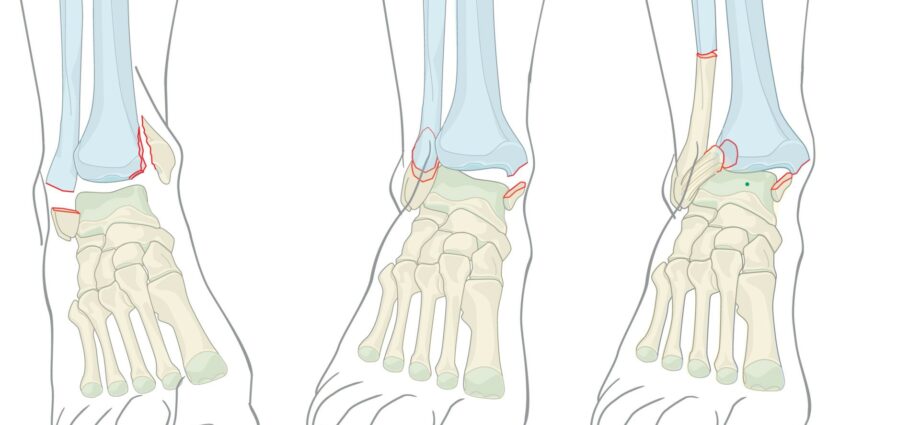Contents
Malleolus: what to do in case of a fracture of the malleolus?
The malleolus fracture is a fracture of the ankle. It should not be neglected: poorly treated, it can quickly develop into disabling osteoarthritis.
The malleolus, which malleolus?
Each ankle has two malleoli. There are indeed two bony protuberances above the foot:
- the medial malleolus (or internal malleolus), bony protrusion located at the lower end of the tibia, on the inner side of the ankle;
- the lateral malleolus (or external malleolus), located at the lower end of the fibula (ex-fibula), on the outer side of the ankle.
These two tuberosities are placed on either side of the talus, with which they are firmly linked by several ligaments, to form the joint.
How do you break the malleolus?
The malleolus fracture occurs when the ankle is excessively twisted, after a fall, trip, poor landing (in basketball or gymnastics, for example) or a blow to the ankle (during a game of football or rugby, in particular). They are common in people wearing high heels. More rarely, it may be ae stress fracture, without any particular traumatic event, in an overweight person or having excessive sports training.
Even if the fracture occurs under the same circumstances as a ankle sprain, it is not treated in the same way. If the bone is broken, make sure that it will repair itself in the right position and that no debris will rub painfully into the joint, which will wear down the cartilages and risk quickly causing a Osteoarthritis crippling ankle. This is why it is always preferable to consult a doctor (general practitioner or emergency doctor), for advice, if you are facing these symptoms:
- severe pain, to the point that it becomes impossible to put your foot on the ground. It is particularly acute around the malleolus;
- swelling of the ankle and foot;
- blood effusion in the ankle;
- in the most severe cases, you may feel that a bone fragment is displaced, or observe that the foot is no longer quite in line with the leg.
Most often, the fracture affects only one malleolus, but sometimes, in cases of severe trauma, both are injured. This is called a bi-malleolar fracture.
When the torsion has been particularly sudden, it is common to have a ligament rupture in addition.
Several types of malleolus fracture
There are several types of malleolus fracture, which can be classified into two main categories:
- simple fractures : stable and not displaced, they present only two or three pieces of bone which, although they are broken, have not moved. The ligaments are not ruptured, or not completely;
- complex and unstable fractures, meet at least one of the following conditions: the bone has fragmented into multiple pieces, one of these fragments has moved and is likely to heal in the wrong place, several ligaments are ruptured.
The symptoms are similar in all of these situations, but the treatments differ.
What treatment for a fractured malleolus?
While waiting for the diagnosis, the best is to put your ankle at rest and immobilize it so as not to risk worsening the fracture, but also to elevate the foot and put a cold compress on the ankle to make it deflate. Pain medication, taken in moderation, may help.
If the fracture is confirmed, the patient is referred to an orthopedic surgeon, who will decide on the therapeutic strategy. This depends on several factors, including the type of fracture and its location on the bone, associated ligament damage, the general condition of the patient, the quality of his bones, etc.
Fracture simple
If no bone fragment has moved, the treatment can be orthopedic: the ankle is immobilized in a cast, a splint or a walking boot for several weeks (six on average). This both keeps the bones in place and protects the foot while the injury heals.
The healing takes longer or shorter depending on the individual. At the end of this period of immobilization, a new x-ray will be taken to verify that the bone is properly repaired. Rehabilitation can then begin. It is very important to follow it, to soften the joint, stiffened by a long immobilization, and to strengthen the ankle.
Complex fracture
Surgical treatment is necessary to reposition the bones, fix them with metallic material (plate, screw, even pin) and, possibly, repair the ruptured ligaments. This osteosynthesis is performed under locoregional or general anesthesia, and requires a scar next to the injured malleolus.
After the operation, it is important to follow the surgeon’s instructions regarding downtime, rehabilitation and gradual resumption of activities. This avoids complications: disassembly of the equipment, subsequent stiffness, etc.
The time to bone healing varies from individual to individual, as does the time to recovery. It takes between three and twelve months to regain a normal ankle.
Special cases
While the risks of surgery are greater than the consequences of poor fracture reduction, surgeons favor orthopedic treatment, even in the event of a complex fracture. This may be the case in an elderly patient with osteoporosis.
Diagnostic
After clinical examination of the ankle, if the doctor suspects a fracture, he orders x-rays of the foot, or even of the entire leg, since the fibula can be fractured relatively high. If he also suspects ligament damage, he will also order an ultrasound of the foot.
A CT scan may also be requested for a better spatial appreciation of the lesions before surgery.










